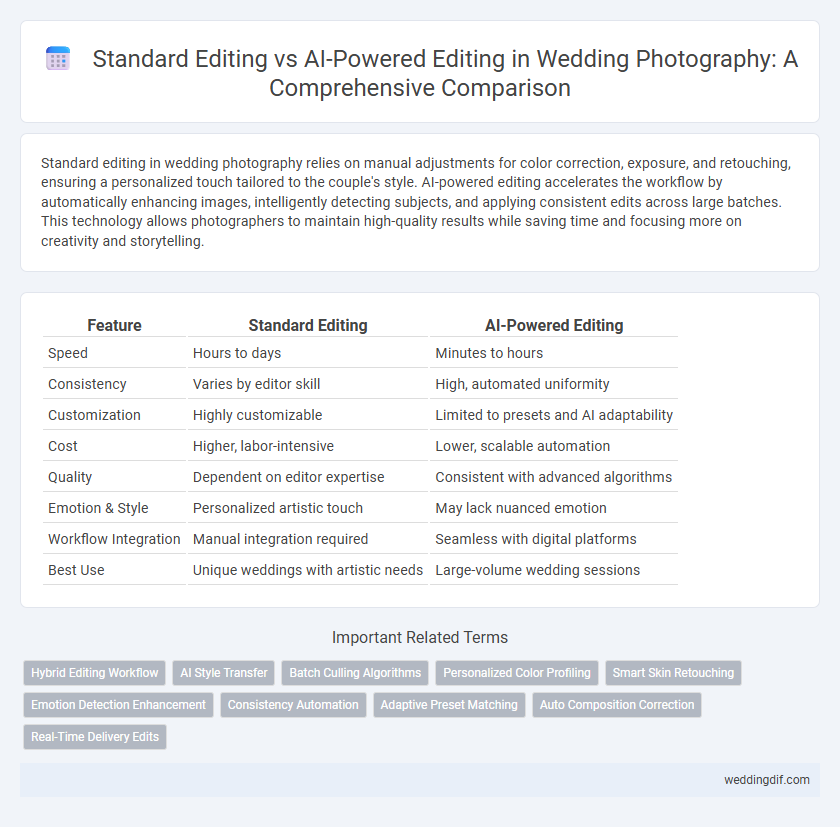Standard editing in wedding photography relies on manual adjustments for color correction, exposure, and retouching, ensuring a personalized touch tailored to the couple's style. AI-powered editing accelerates the workflow by automatically enhancing images, intelligently detecting subjects, and applying consistent edits across large batches. This technology allows photographers to maintain high-quality results while saving time and focusing more on creativity and storytelling.
Table of Comparison
| Feature | Standard Editing | AI-Powered Editing |
|---|---|---|
| Speed | Hours to days | Minutes to hours |
| Consistency | Varies by editor skill | High, automated uniformity |
| Customization | Highly customizable | Limited to presets and AI adaptability |
| Cost | Higher, labor-intensive | Lower, scalable automation |
| Quality | Dependent on editor expertise | Consistent with advanced algorithms |
| Emotion & Style | Personalized artistic touch | May lack nuanced emotion |
| Workflow Integration | Manual integration required | Seamless with digital platforms |
| Best Use | Unique weddings with artistic needs | Large-volume wedding sessions |
Understanding Standard Editing in Wedding Photography
Standard editing in wedding photography involves manual adjustments such as color correction, exposure balancing, and retouching performed by skilled editors using software like Adobe Photoshop and Lightroom. This process emphasizes preserving the natural look and emotional authenticity of the images while enhancing details like skin tones and lighting. Understanding the nuances of standard editing helps photographers maintain control over creative decisions and ensure consistent quality in the final wedding album.
Introduction to AI-Powered Editing for Weddings
AI-powered editing for weddings leverages advanced algorithms to enhance photos with precision, adjusting lighting, color balance, and removing imperfections automatically. Standard editing involves manual adjustments by photographers using software like Adobe Photoshop or Lightroom, requiring more time and expertise. AI tools streamline the post-production process, delivering consistent, high-quality results while allowing photographers to focus on creative aspects.
Speed and Efficiency: Which Method Wins?
AI-powered editing significantly outperforms standard editing in speed and efficiency, processing large batches of wedding photos within minutes while maintaining consistent quality. Traditional manual editing demands hours of meticulous adjustments, which can delay delivery times and increase costs. Leveraging AI algorithms for tasks like color correction, noise reduction, and facial retouching streamlines the workflow, enabling photographers to meet tight deadlines without sacrificing artistic precision.
Consistency in Wedding Photo Editing: Standard vs AI
Standard editing in wedding photography often leads to variability in color grading and retouching due to human subjectivity and fatigue. AI-powered editing ensures consistent application of presets and adjustments across large batches of wedding photos, maintaining uniform tones, exposure, and skin retouching. This consistency enhances the overall visual storytelling and client satisfaction by delivering a cohesive wedding album.
Artistic Control: Human Touch vs Machine Precision
Standard editing in wedding photography offers unparalleled artistic control, allowing photographers to infuse images with personal style and emotional nuance through manual adjustments. AI-powered editing provides machine precision, enabling rapid enhancements and consistent color correction, but may lack the subtlety of human interpretation. Balancing human touch with AI efficiency can elevate wedding photos by combining creativity with technical accuracy.
Cost Comparison: Traditional Editing vs AI Solutions
Traditional wedding photo editing typically requires 2 to 5 hours per session, costing between $100 and $300 per event depending on the editor's expertise and software used. AI-powered editing solutions reduce this time drastically to under 30 minutes per session, lowering costs to around $30 to $80 per event while maintaining consistent image quality. The cost savings stem from automation of tasks like color correction, retouching, and background adjustments, making AI an efficient and budget-friendly option for wedding photographers.
Scalability for Large Wedding Albums
Standard editing for large wedding albums often demands extensive manual labor, limiting scalability due to time constraints and consistency challenges. AI-powered editing streamlines the process by automating repetitive tasks such as color correction, skin retouching, and background enhancements, significantly speeding up workflow. This technology enables photographers to efficiently handle large volumes of images while maintaining high-quality, uniform edits across extensive wedding collections.
Customization and Personalization in Editing Styles
Standard editing in wedding photography relies on predefined presets and manual adjustments, offering moderate customization tailored to a photographer's signature style. AI-powered editing enhances personalization by analyzing individual photos and client preferences, enabling adaptive adjustments such as skin tone correction, lighting balance, and background enhancement with greater precision. This technology accelerates the editing process while maintaining a unique, consistent aesthetic aligned with the couple's vision.
Error Rates and Quality Assurance
Standard editing in wedding photography relies on manual adjustments, often resulting in higher error rates due to human fatigue and subjective judgment. AI-powered editing reduces errors by using advanced algorithms to consistently enhance image quality, ensuring uniform color correction, exposure, and retouching. Quality assurance improves significantly with AI tools that can detect imperfections and apply precise corrections, delivering polished, professional wedding photos with minimal human intervention.
Future Trends in Wedding Photo Editing
Future trends in wedding photo editing emphasize AI-powered editing for its ability to enhance efficiency and precision in color correction, retouching, and background adjustments. Unlike standard editing, AI algorithms can quickly analyze and perfect large batches of photos, delivering consistent results that meet the evolving aesthetic preferences of modern couples. Integration of machine learning and augmented reality tools promises more personalized, creative, and immersive wedding photography experiences.
Standard Editing vs AI-Powered Editing for weddings Infographic

 weddingdif.com
weddingdif.com